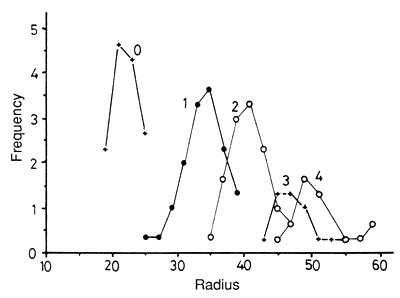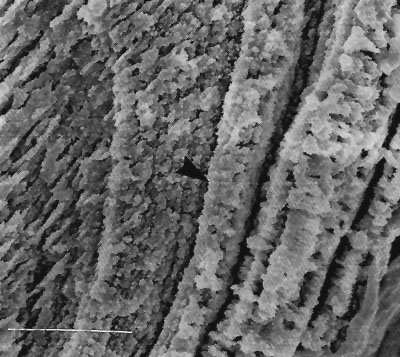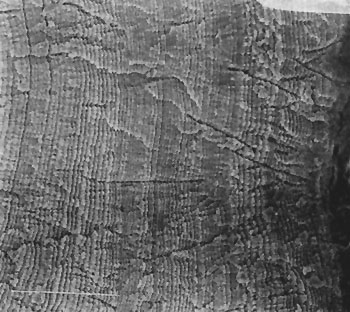Age structure determination of a fish stock from growth structures is based on the assumption that growth increments occur simultaneously at standard intervals within a specific cohort, in the form of regular depositions of new growth structures. In beginning the study of a stock, compliance with the two basic criteria: periodicity and synchronous development, must be assured. Extrapolation of the results from other populations is not a valid technique (Beamish and MacFarland, 1983).
Validation methods can be divided into direct and indirect methods. The lapse of time between two determined events is known in direct validation and therefore the periodicity of the increments can be read. In indirect validation methods, the medium lengths of each age class, read on the basis of growth increments, are compared with those obtained by other methods. When the results concur, the use of growth increments as a technique is considered valid. This approach is used with species that cannot be reared or maintained in captivity and with those for which only fishery data are available.

Fig. 10. Distribution of distances from the centre of the otolith to each ring considered to be an annual ring in Lethrinus.
The most precise method of determining increment periodicity is to rear the fish and to sacrifice them in sequence. In examining the otoliths, the age at which ring formation begins will be determined (number of days between spawning and first increment) as will increment periodicity.
The interval between spawning and reabsorption of the vitelline sac requires intensive study to determine the exact start of formation. The start depends on the length of the embryonic period and the fish species. Generally speaking, the beginning coincides with spawning or with the onset of active feeding (Brothers et al., 1976; Geffen, 1983; Marshall and Parker, 1982; Mcgurk, 1984; Neilson and Geen, 1982; Stenffensen, 1980; Wilson and Larking, 1980; Yzeng and Yu, 1988).
In plotting the number of otolith increments against the number of days from birth, you will obtain a lineal slope relationship not significantly distinct from I. The ordinate in the abscissa axis will indicate age at the onset of deposition. The number of samples to be observed is determined by assigning a confidence limit of 95 percent in calculating individual age from the linear relationship.
Otoliths can be marked or tagged with a systemic chemical which acts as a reference, thus making it possible to work with fish of unknown age, as the interval between tagging and sacrifice is known, making it easy to determine growth (Wild and Foreman, 1980).
Capture, tagging and release into the environment has been done with hardy species which survive the resultant stress and which can be tagged in sufficient numbers to guarantee recapture. Although their growth will be affected by handling, it will also reflect growth under natural conditions.
When fish are held in captivity, a period of acclimatization must be allowed before beginning the experiment so as to avoid stress-caused growth slowdowns and the consequent checks or discontinuities in the otolith.
Tetracycline is the most common marker: it acts to chelate the calcium and magnesium present in the calcified tissues. Under ultraviolet light and the fluorescent microscope, the tetracycline band will appear as a yellow ring against the green background of the otolith. Tetracycline is broken down by light and so the otoliths must be kept in the dark (Chilton and Beamish, 1982).
Tetracycline in the form of OTC (tetracycline hydrochloride) is offered in the fish feed or given as an intraperitoneal injection at concentrations of 25–30 mg per kilo of fish weight (Wild and Foreman, 1980). Mass marking of larval and juvenile fish involves their immersion for 120 minutes in a 500 mg/l solution of tetracycline in distilled water with 3.5 percent of buffered NaCl at a pH of 6.0–6.2 (Hettler, 1984; Schmitt, 1984).
A large number of specimens in marking experiments often present diffuse fluorescent bands or none at all (Chilton and Beamish, 1982). In marking experiments with Lutjanus kasmira, evidence emerged to show that the amount of tetracycline fixed during periods of slow growth was too small to produce a readable fluorescent band (Morales-Nin, Ralston and Uchiyama, unpublished data).
Otoliths can be marked for SEM viewing, producing visible growth checks induced by immersing the otoliths for 18 hours in an acetolamide solution of 125 ppm (Ralston and Miyamoto, 1981) or through experimental stress induced by anoxia or thermal shock (Fig. 11) (Pannella, 1980).
It is common in this type of experiment to encounter broad individual variation in the time and frequency of formation of the mark in the otolith. Therefore, many individuals must be marked to guarantee that the experiment is productive. Fish which are not clearly marked or which have a diffuse fluorescent ring are very frequent.
The ratio of days after marking to the increments formed will indicate the process of formation. A linear ratio starting at O indicates correspondence (number of days = number of increments): when the origin is other than zero it indicates a period of latency prior to the onset of formation. Where the relationship is non-linear, there may be no correspondence, or the increments may be too fine to be detected under the light microscope.

Fig. 11. Otolith growth check caused by severe environmental stress. Scale 12 μm.
The birthday of an individual fish can be back-calculated from the date of capture and the age reading (Methot, 1983). A comparison of this date with the spawning period of the species will provide a check on the precision of the age reading.
The method is only applicable to larval and juvenile fish as selective mortality can alter the results in adults. Discrepancies between the estimated date of birth and the spawning period may be due to growth checks or deviations in daily periodicity (Geffen and Nash, 1985).
The cyclical growth patterns - weekly, monthly and seasonal which form in otoliths (Fig. 12) depend on regularly occurring external factors. When patterns of growth are regular and attributable to an environmental stimulus, their periodicity allows the determination of increment formation frequency. In coastal species with cycles of 7–14–28 increments, daily periodicity in the otoliths may be assumed (Geffen, 1987). Similarly, the number of increments in a seasonal ring has been used to determine periodicity (Gjosaeter et al., 1983).
The metamorphic phases in the larval period are reflected in the otolith's nuclear structure (Brothers and MacFarlan, 1981; Marshall and Parker, 1982). The age of the various metamorphic phases is known for many species and can therefore be related to the otolith structure (Geffen, 1987).
Increment deposition depends on an internal rhythm which is synchronized with environmental fluctuations and prompted by a cyclical stimulus (Campana and Neilson, 1985). A group of fish subjected to the same environmental conditions should form their increments at the same time. By repeatedly sampling the fish throughout a day-period, the development of the increment on the edge of the otolith can be followed and its periodicity determined.

Fig. 12. Cyclical groups: otolith growth in Haplochcomis, probably related to rhythmic environmental variations (scale 86 μm).
The percentage of marginal increment deposition (c), determined by measuring the increment in the process of formation (In) and of the one immediately anterior to it (In-I):
c = 100(In/In-I)
will make it possible to determine the time when the increment was formed (Mugiya et al., 1981).
This method has been applied to fish reared in captivity (Morales-Nin, 1985 b) and to fish who remain in the same area and do not migrate vertically during the day (Ré, 1983). The method is only applicable to larval and juvenile fish, as the marginal increment of adult fish otoliths is usually damaged during preparation.
d) Progression of the median age, if the population is made up primarily of one age class which, once recruited, does not migrate. In this case the evolution over time of the mean ages will make it possible to determine the periodicity of increment formation (Darayatne and Gjosaeter, 1986).
Similarity between growth curves plotted from increments and those plotted from other methods can provide validation of the age readings determined by counting increments. In comparing the various growth curves, similar length ranges should be considered as the rate of growth varies with age.